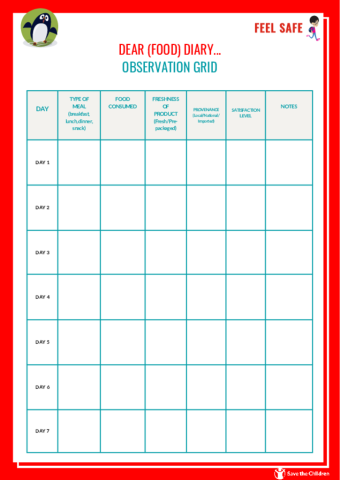Dear (food) diary...
Before starting
The teacher explains to the class how eating habits contribute to the pollution of the planet, bringing attention to the fact that changing our food choices can reverse the trend. The challenge of the new century is precisely to rediscover and return to more sustainable and conscious food practices.
To guide discussion and exchange of thoughts on the topic, the teacher can show these videos:
My food diary
The teacher provides students with an observation grid to fill out at home over a seven-day period (see attached “Dear (food) diary... - Grid” below). The following information will need to be recorded each day:
- Date and Time: Specify the day and time the meal was eaten.
- Type of Meal: Record whether it was breakfast, lunch, dinner or snack.
- Food consumed: List the foods and beverages consumed, specifying quantities. Servings may be indicated (e.g., one orange, two slices of bread, 200g yogurt).
- Freshness of Product:
- Fresh: Seasonal fruits and vegetables, local and unprocessed produce.
- Prepackaged: Packaged foods, snacks, ready-to-eat meals, etc.
5. Provenance:
- Local (km 0): Products purchased from local markets or stores.
- Domestic/Imported: Food from other regions or countries.
6. Satisfaction:
Indicate whether the meal was enjoyed and whether it was all finished. Use a scale of 1 to 5 to express the level of satisfaction.
7. Observations/Notes:
Personal reflections on how one felt after eating: “Did I feel energetic?”, “Did I have a decrease in energy?”, “Was I hungry after the meal?” “Was there any food left over? What did I do with it?”
The sustainability of our diet
At the end of the observation week, the class shares their grids in plenary. The teacher leads the discussion and writes the following food categories on the blackboard, noting how widespread some eating habits are among children:
- eco-sustainable foods
- more polluting foods
- simple km0 foods
- prepackaged foods
- meat
- fish
- fresh fruit
- cheeses
- frozen foods
- snacks
The teacher stimulates reflection starting with the degree of satisfaction that various types of foods gave children, taking care to specify that usually a higher level of liking and satisfaction associated with packaged products such as snacks and chips is exclusively caused by the role that sugars, preservatives and artificial flavors in such foods play in increasing addiction and dependence on them.
Concluding thoughts
Considering the observations made throughout the week, the teacher invites students to reflect on some of the most effective ways to reduce the environmental impact of their food choices. These “best practices” represent simple but meaningful actions that each of us can take to contribute to a more sustainable future.
- Avoid food waste
- Reduce one's consumption of meat
- Pay attention to the provenance of food, preferring foods from 0 km
- Buy products in season
- Prefer organic farms
- Avoid pre-packaged foods
Every action counts, and by integrating these practices into our daily lives, we can contribute to a more sustainable future for all.

Add new comment